Degree in English GrammarEnglish is a complex language with a variety of nuances that can be difficult to understand, even for native speakers. One of the most important aspects of English grammar is degrees, which describe the intensity of an adjective or adverb. This is a crucial concept for anyone who wants to master the language, as it is an essential tool for expressing oneself clearly and effectively. This post will explore the different degrees in English grammar and how to use them properly. 
Degrees in English Grammar - AdjectivesIn English Language, Adjectives are words utilized to describe and provide additional information about nouns in a given sentence or context. There are instances where multiple nouns possess the same quality, or one noun may have a better quality than the others. To compare such similar qualities, we can use degrees of comparison. This article provides a comprehensive guide to understanding degrees of comparison in English grammar, including their definition, the various degrees of comparison, their usage, and the rules to follow while using them. Additionally, the article includes several examples to help readers understand the concept better. 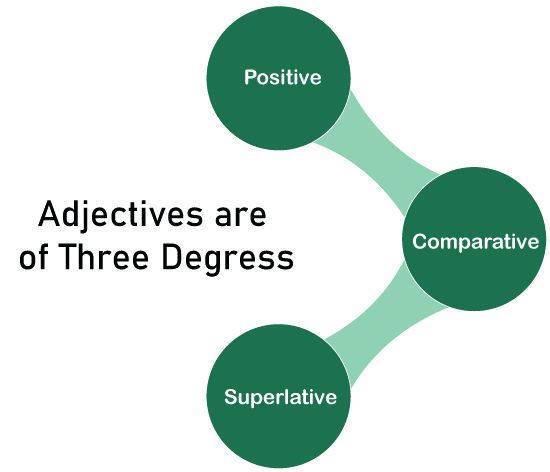
As stated above, adjectives are utilized to describe and provide more information about nouns in a sentence. When comparing nouns with similar qualities, we use degrees of comparison. The Collins Dictionary describes the degrees of comparison as the positive, comparative, ad superlative degrees of an adjective or adverb. Degrees in English Grammar - AdjectiveThere are primarily 3 degrees of comparison in English grammar: the positive, comparative, and superlative. Positive DegreeThis is the fundamental type of degree in adjective and does not allow for comparison. It simply provides information about a particular quality of a noun. Positive Degree Examples
Comparative DegreeThe comparison degree is utilized for comparing two nouns that have which have the same quality or the specific quality of a noun at two separate times. It showcases which of the two has a more or less degree of the quality being referred to. Comparative Degree Examples
Superlative DegreeThis degree is the highest degree for comparison and is utilized for comparing equivalent qualities shared by two or more nouns. It demonstrates the various nouns being compared and indicating the one that has the most or least degree of the provided quality or qualities. Superlative Degree Examples
Examples of each degree of comparison are provided above. By understanding the different degrees of comparison and the rules for using them, you can effectively compare and describe nouns in English grammar. 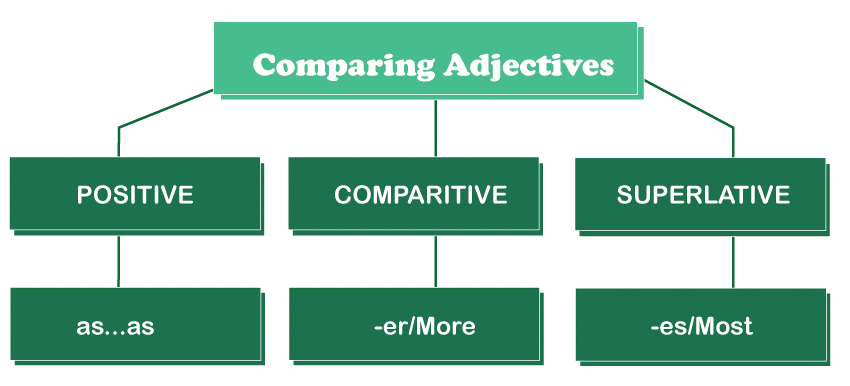
Degrees in English Grammar - AdverbIn English grammar, adverbs have three degrees: positive, comparative, and superlative. These degrees are used to show the level or intensity of an action or quality that an adverb modifies Positive degree: The positive degree of an adverb is the basic type without any comparison. It simply describes how an action is performed. For example, "He talks clearly." In this sentence, the adverb "clearly" alters the verb "talks" and gives a description of how he talks. Comparative degree: This degree of an adverb is utilized for comparing two actions or qualities. It is created by adding "-er" to the adverb or by utilizing the term "more" before the adverb. For example, "He speaks more clearly than she does." In this sentence, the comparative degree of the adverb "clearly" is used to compare the way he speaks with the way she speaks. Superlative degree: The superlative degree of an adverb is used to compare one action or quality with all others in a group. It is created by including "-est" to the adverb or by using the word "most" before the adverb. For example, "He speaks the most clearly of all the candidates." In this statement, the superlative degree of the adverb "clearly" is used to compare the way he speaks with all other candidates. 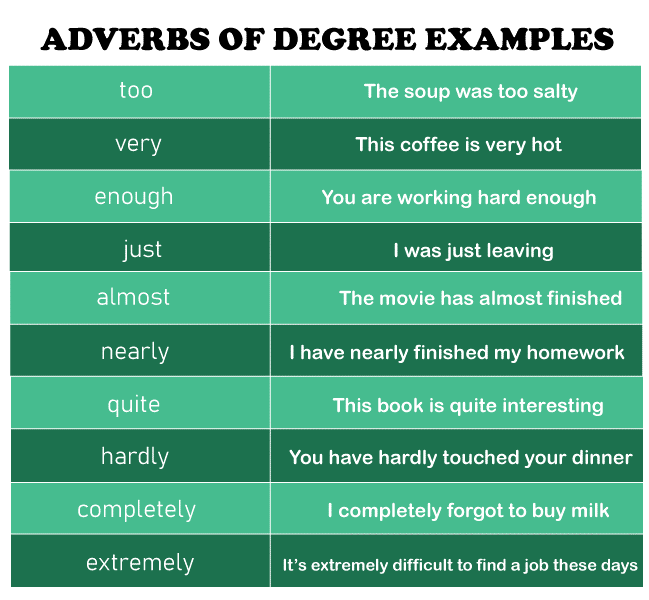
It's important to use the correct degree of an adverb to accurately convey your message. Using the wrong degree could lead to confusion or misinterpretation. By using the appropriate degree of an adverb, you can add more detail and precision to your writing or speech. List of Degree of ComparisonThe list of degrees of comparison is categorized into different types based on the rules for forming the comparative and superlative degree for comparison. It is important to note that not every adjective follows the rule of adding '-er' and '-est'. The various types of degrees of comparison are: Type 1: Monosyllabic adjectives where the final consonant is doubled, and 'er' and 'est' are added. Example: Big, bigger, biggest Thin, thinner, thinnest Type 2: Monosyllabic adjectives with the last consonant accompanied by another consonant or two vowels, where 'er' and 'est' are added. Example: Fast, faster, fastest Sweet, sweeter, sweetest Type 3: Adjectives ending in 'e' where 'r' and 'st' are added. Example: Large, larger, largest Fine, finer, finest Type 4: Adjectives ending in 'y' where 'ier' and 'iest' are added. Example: Happy, happier, happiest Dirty, dirtier, dirtiest Type 5: Polysyllabic adjectives where 'more' and 'most' are added. Example: Beautiful, more beautiful, most beautiful Careful, more careful, most careful Type 6: Irregular adjectives which do not follow any set pattern. Example: Good, better, best Bad, worse, worst What are the Rules and Points to Remember When Using Degrees of Comparison?When utilizing degrees of comparison, like with any other grammatical element in English, it's essential to remember certain guidelines. Here are some things to keep in mind:
Why Are Comparison Degrees Significant?If you intend to study a foreign language, knowing the phrases comparative and superlative is a good place to start because it will help you learn the principles for generating them. Aside from that, here are five important degree-related difficulties. (Issue 1) Dual comparatives and superlatives are both major grammar errors. Do not use two rules to make a comparative or superlative. She gets more whackier as the evening passes by. incorrect She is the most fastest athlete. incorrect These are known as double comparatives or double superlatives. They are more popular in conversation than in writing. They can be disregarded as a slip of the tongue when spoken. If you employ one in writing, you're doomed. Shot at credibility. (Issue 2) When comparing two items, utilize the comparative degree instead of the superlative degree. When comparing only two items, it is a common error to use the superlative degree. (This is the time to use the comparative degree. ) She is the most qualified of the two pupils. incorrect (A more qualified contender would be correct. ) White is the most compelling non-color in my opinion; it's clean, cheerful, and forceful. proper checkmark (Jason Wu, artist ) (When I found this phrase, I intended the non-colors to be just black and white, which would have made the meaning more forceful. It turns out that the non-colors also contain all of the greys. As a result, Wu's remark is correct. Gutted.) Oftentimes, the number of items being compared is unknown. Mary is the most suitable person. (Based on this, we'd guess there were more than two applicants. If there were only two, it should state "more suitable. " (Issue 3) "Dead" denotes death. You can't possibly be deader...or can you ? Some adjectives, it could be argued, should not have comparative or superlative forms since their meanings already represent the attributes to the greatest extent feasible. Here are four adjectives that may get criticism if employed in a comparative or superlative sense. (They are arranged according to their ability to annoy.)
(Issue 4) As an adverb, "speedier" or "more speedily" might be used. Both "speedier" and "more speedily" are valid comparative forms of the adverb quickly. It's a popular fallacy that "faster" only recently become an adverb in English due to common usage and a lack of understanding of the distinction between adverbs and adjectives. "Quicker" was significantly more frequent than "more quickly" for the majority of the nineteenth and twentieth century. "More quickly" has surpassed "quicker" solely since the 1970s. The other eccentric comparative is "stupider", which is an effective option to "more stupid". Consider how stupid the typical person is; 50 per cent of us are stupider. Correct(George Carlin, comedian) (Issue 5) Both "bigger than me" and "bigger than I" are correct. Many authors are unclear about whether to use a structure like "bigger than me" or "bigger than I" when utilizing the comparative degree. The short answer is that both are right, but not everybody agrees, which is the issue. Here's the crux of the issue: than can be either a conjunction or a preposition. When than is utilized as a conjunction (remember, a conjunction unites like phrases), the result is as follows: Jack is bigger than I am. Alternatively, John is bigger than I. (This is only a shortened version.) When than is utilized as a preposition (a preposition indicates the connection between words), the result is as follows: Jack is bigger than me. Grammar experts have been debating whether the term "than" is a conjunction or a preposition in this structure for numerous years. Most people prefer the "than me" variant, but this is the variant that is more likely to be challenged since it "than I" variant has been around longer and, to many, appears more grammatically proper. Others, however, find the "than I" variant pompous. Thus, there is a lot to consider without any firm rules. Unfortunately, it is not as easy as doing anything you would like to and stating, if questioned, that the world's grammar experts have been arguing about this subject for hundreds of years. Another point to consider is that the "than me" form can occasionally generate uncertainty. Consider the following example: Jack likes Steven more than me. This could suggest that Jack likes Steven more than I like Steven. or Jack likes Steven to me. Using the "than I" version and expanding the statement is an excellent technique to eliminate this uncertainty (which implies adding at least the verb). Jack likes Steven more than I do. or Jack likes Steven more than he likes me. This construction will also shield you from allegations of arrogance. Common Mistakes In Degree In English GrammarOne of the most common mistakes in degrees in English grammar is using the wrong form of the adjective or adverb when making comparisons. Here are a few examples of common mistakes: Using the comparative form when only two items are being compared: Sometimes people use the comparative form of an adjective or adverb when there are only two items being compared. For example, saying "She is the taller of the two cousins" instead of "She is the tallest of the two cousins." Using the wrong form of the adjective or adverb in the superlative degree: Sometimes people use the comparative form of an adjective or adverb instead of the superlative form when they are trying to compare one item with all others in a group. For example, saying "She is the most tall" instead of "She is the tallest." Not using comparative or superlative forms when necessary: Sometimes people do not use comparative or superlative forms of adjectives or adverbs when they are needed. For example, saying "He runs good" instead of "He runs well" or "He runs better than I do." Overusing intensifiers: Sometimes people use too many intensifiers, such as "very" or "extremely," when describing something. This can make writing or speech sound exaggerated or insincere. For example, saying "He is extremely, very talented" instead of "He is very talented." Incorrect use of comparative and superlative forms: Confusing when to use "more/most" and "less/least" instead of adding "-er/-est" to the adjective. For example, saying "more better" instead of "better" or "most smartest" instead of "smartest". Double comparison: Using both comparative and superlative forms together in a sentence, like "This is the most clearest explanation I've ever heard". Incorrect use of "than" in comparisons: Forgetting to use "than" after the comparative form of an adjective or adverb when making a comparison. For example, saying "She is taller her friend" instead of "She is taller than her friend". Unequal comparisons: Comparing two things that are not of the same category or do not have the same attributes. For example, saying "This apple tastes better than that book" makes no sense. Incorrect use of adjectives and adverbs: Confusing when to employ an adjective to describe a noun, and an adverb to describe a verb or an adjective. For example, saying "She sings good" instead of "She sings well". Overuse of comparatives and superlatives: Using too many comparative or superlative forms in a sentence, which can make the sentence sound repetitive and awkward. For example, saying "This is the most best pizza I've ever had" is redundant. Inconsistent comparisons: Making a comparison but switching the objects being compared midway through the sentence. For example, saying "My cat is cuter than my dog is big" is unclear and confusing. Using comparative or superlative forms with absolute adjectives: Using comparative or superlative forms with adjectives that cannot be graded, like "unique" or "perfect". For example, saying "This is the most unique idea" is incorrect, as "unique" cannot be compared. To avoid these common mistakes, it's important to carefully consider the comparisons you are making and choose the appropriate form of the adjective or adverb for the degree you want to express. Differences Between Adjective and Adverb DegreesAdjective degrees are used to describe the level of comparison between two or more nouns, such as size, quality, or quantity. Adjectives have three degrees of comparison: positive, comparative, and superlative.
Adverb degrees, on the other hand, are used to describe the level of comparison between two or more verbs, indicating the manner in which an action is performed. Adverbs also have three degrees of comparison: positive, comparative, and superlative. The positive degree is the simplest form of an adverb, indicating the basic manner in which the verb is performed. The comparative degree is used to compare two verbs, showing which one is performed better or worse than the other. The superlative degree is used to compare three or more verbs, indicating which one is performed the best or worst. 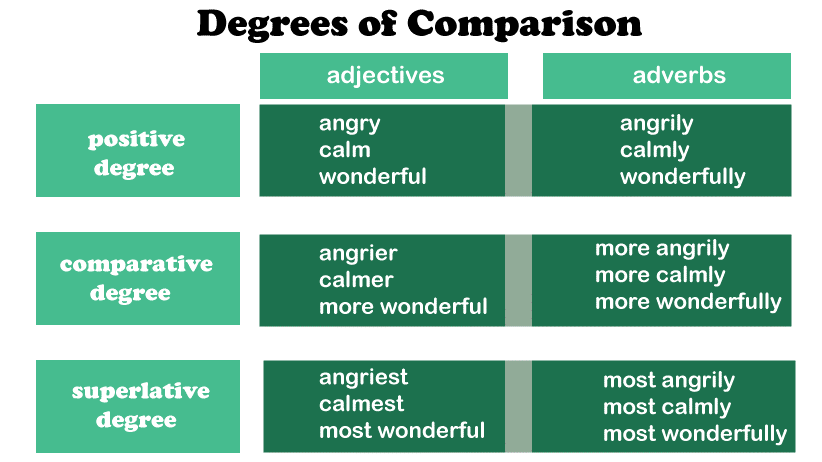
Examples Of When to Use Each Degree In A SentenceAdjective DegreesPositive degree: The car is fast. Comparative degree: The red car is faster than the blue car. Superlative degree: The black car is the fastest of all. Adverb DegreesPositive degree: She speaks fluently. Comparative degree: He speaks more fluently than she does. Superlative degree: They both speak fluently, but he speaks the most fluently of all. 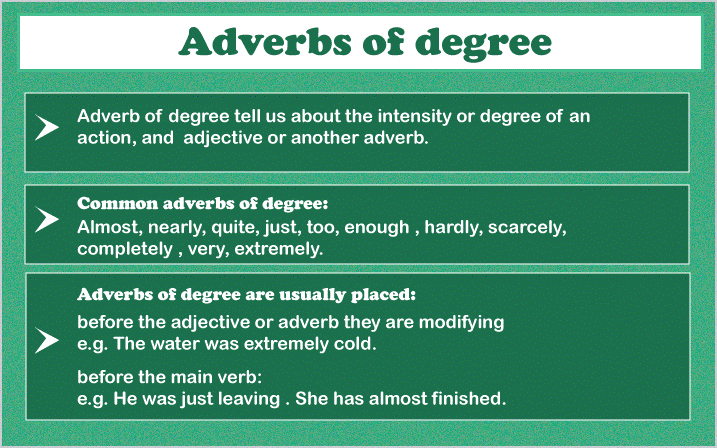
Tips For Mastering Degrees in English GrammarHere are some tips for mastering adjective and adverb degrees in English grammar: Familiarize yourself with the rules: Learn the rules for forming comparative and superlative degrees of adjectives and adverbs. This includes knowing when to add -er or -est and the right place and time to employ the term more or most. Memorize irregular forms: Certain adjectives and adverbs have uneven comparative and superlative forms, like good-better-best and well-better-best. Memorize these forms so you can use them correctly in sentences. Pay attention to context: The choice of degree often depends on the context in which it is used. For example, the comparative degree may be appropriate when comparing two things, while the superlative degree may be used when comparing three or more things. Practice using degrees in sentences: The best way to master the use of degrees is through practice. Write and speak sentences using different degrees of adjectives and adverbs to become more comfortable with their usage. In conclusion, understanding degrees in English grammar is crucial for effective communication. Adjectives and adverbs play a vital role in describing the quality, quantity, and manner of actions and things. Mastering the three degrees of comparison for both adjectives and adverbs (positive, comparative, and superlative) is essential to convey information accurately and effectively
Next TopicLinkers in English Grammar
|
 For Videos Join Our Youtube Channel: Join Now
For Videos Join Our Youtube Channel: Join Now
Feedback
- Send your Feedback to [email protected]
Help Others, Please Share










